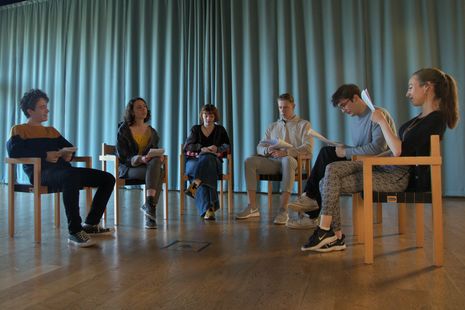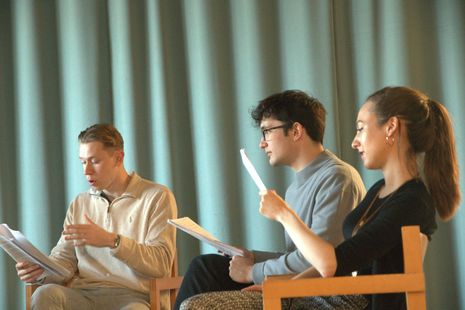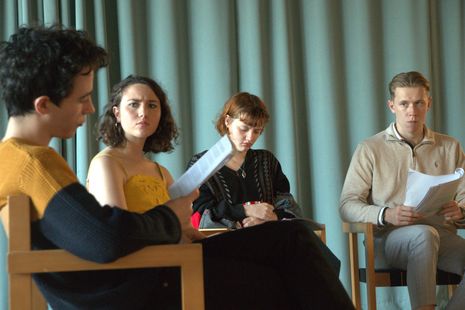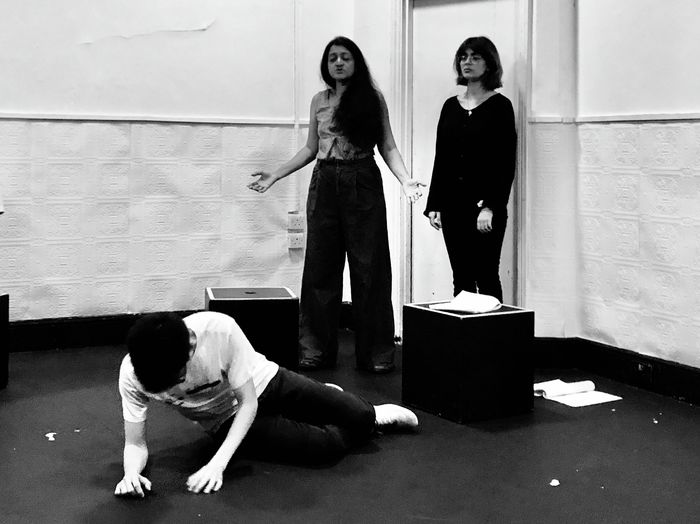The Waves: Blurring the boundary between the literal and the lyrical
Sarah Taylor discusses her experience adapting Virginia Woolf’s strange, haunting words for stage

Adaptation as a creative process fascinates me no matter the media, but I find it especially interesting as a movement from page to stage. To condense an entire novel into a play is to distill that work into something that speaks more immediately to a wider audience; but it is also to impose your own interpretation. This makes it a risk, especially with a novel as beloved as The Waves. There is no way of pleasing everybody in adaptation - the beauty of ambiguity in literary fiction is necessarily reduced somewhat in the play form. Of course, you strive to keep as much of the source text as you can but you have to lose some of its density unless you want to lose your audience’s attention. The Waves isn’t even a long novel, but it is a rich one; my Oxford edition is only 177 pages, but when you consider that this must be boiled down to around 40 pages of script, there is a lot of loss in that concentration.
Not a single word in the script has been added
In fact, it turns out that adaptation in my case was mostly mastering Ctrl-X. Most novel adaptations would be faced with the challenge of mapping descriptive passages onto set and staging and creating dialogue to fill in for lost plot narration. The Waves, however, is ready-made as a series of monologues, from which I simply needed to select the most relevant or interesting extracts to keep in performance. As they age, each character says what is on their minds in turn (though I don’t think we are to assume they actually “said” all of their reflections, if any, out loud) and these parenthetical “Louis said” or “Jinny said” moments are the closest we get to a single narrator. The rest is already framed as spoken by the characters, and therefore seems to naturally transpose to script. Perhaps this is why I was so struck with the notion that the novel should be performed when I first read it three years ago.

The discovery that Woolf considered the novel a kind of ‘play-poem’ came as no surprise - the lyricism of the language and immediacy of the form certainly speak to both disciplines - but the discovery that there was no publicly accessible script version of the play was more intriguing. I knew of various adaptations of Woolf novels, so I had almost expected to find one readily available for The Waves. That was not the case. When people ask me why I decided to adapt The Waves, I fear that my genuine answer - that there was no other script of the novel to stage - comes across as flippant. In hindsight, I think it proves how deeply I wanted to see the novel performed, but at the time I barely stopped to think about why; I just started writing - or, rather, cutting.
Woolf is out of copyright, which means I was allowed to do that, and moreover could do it by copying and pasting the entire novel from Project Gutenberg Australia (I don’t know why, either), removing all the “Susan said” and “Neville said” interruptions, and cutting from that point on. If this sounds like an un-scholarly approach, then I guess it was, but it was the easiest way of retaining Woolf’s language exactly, and this was all that mattered to me. Not a single word in the script has been added. I have cut on various levels - many pages of Bernard’s closing monologue, various passages throughout, tangential sentences, clauses that disrupted clarity, images too abstract to be sufficiently expressed on stage, even singular words if in the rehearsal period we felt they tripped us up - but I have never changed a word that Woolf had chosen.

This isn’t the first time the novel has been represented on stage; Katie Mitchell’s devised project for the National Theatre, Waves (2006), played with live film and projection, and in 2015 a ballet series entitled Woolf Works took The Waves as inspiration for its second piece, ‘Tuesday’. There were elements of each that I much admired - the movement of Woolf Works, the multimedia of Waves - but they also showed me things I didn’t want this production to be. The imposition of the author figure in Woolf Works framed the pieces with Woolf’s death, which I feel to be a fact too often clouding interpretations of her work. That said, it is relevant to The Waves, particularly to Rhoda’s arc, and was something we wanted to be sensitive but not explicit about in this play. Mitchell’s production was highly experimental and abstract, replicating the novel’s own innovations, but I wanted a clearer narrative, arguably a more traditional play.
I wanted to prioritise characterisation, because I think these six figures are so complex and compelling, and though they don’t necessarily come from relatable places (Edwardian white upper middle class, anyone?), they do struggle with universal issues, with friendship, jealousy, love, grief, and change. This production, then, has prioritised interaction and emotion over imagery (gorgeous as Woolf’s prose is) in an effort to root the characters to a conceivably real world - one we hope our period aesthetic consolidates. We have aimed to capture the ethereal, ephemeral tone of the novel in other production aspects, using videography, composition, choreography, and ever-changing set to blur the boundary between the literal and the lyrical.
 News / Caius mourns its tree-mendous loss23 December 2025
News / Caius mourns its tree-mendous loss23 December 2025 News / Clare Hall spent over £500k opposing busway 24 December 2025
News / Clare Hall spent over £500k opposing busway 24 December 2025 Comment / Yes, I’m brown – but I have more important things to say22 December 2025
Comment / Yes, I’m brown – but I have more important things to say22 December 2025 Comment / The ‘class’ of Cambridge24 December 2025
Comment / The ‘class’ of Cambridge24 December 2025 Interviews / Politics, your own way: Tilly Middlehurst on speaking out21 December 2025
Interviews / Politics, your own way: Tilly Middlehurst on speaking out21 December 2025








